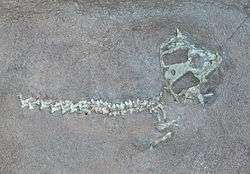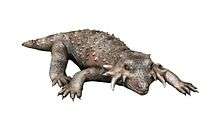Hypsognathus
| Hypsognathus Temporal range: Late Triassic | |
|---|---|
 | |
| Fossil of Hypsognathus fenneri (AMNH 1676) in the American Museum of Natural History | |
| Scientific classification | |
| Kingdom: | Animalia |
| Phylum: | Chordata |
| Class: | Reptilia |
| Clade: | †Parareptilia |
| Order: | †Procolophonomorpha |
| Family: | †Procolophonidae |
| Subfamily: | †Leptopleuroninae |
| Genus: | †Hypsognathus Gilmore, 1928 |
| Type species | |
| †Hypsognathus fenneri Gilmore, 1928 | |

Life restoration of Hypsognathus
Hypsognathus ('high jaw') is an extinct genus of procolophonid parareptile from the Late Triassic of New Jersey and Connecticut.[1]
Hypsognathus resembled a moderately sized lizard, with a length of 33 centimetres (13 in), although it was unrelated to modern lizards. Because of its broad teeth, Hypsognathus is thought to have been a herbivore. Its body is low and broad and it has a relatively short tail. Hypsognathus has some spikes on the side of its head, probably for protection against predators.[2]
References
- ↑ Sues, H.-D.,Olsen, P.E., Scott,D.M, and Spencer, P.S. (2000). "Cranial Osteology of Hypsognathus fenneri, a Latest Triassic Procolophonid Reptile from the Newark Supergroup of Eastern North America" Journal of Vertebrate Paleontology, 20(2):275-284.
- ↑ Palmer, D., ed. (1999). The Marshall Illustrated Encyclopedia of Dinosaurs and Prehistoric Animals. London: Marshall Editions. p. 63. ISBN 1-84028-152-9.
This article is issued from Wikipedia - version of the 9/26/2016. The text is available under the Creative Commons Attribution/Share Alike but additional terms may apply for the media files.